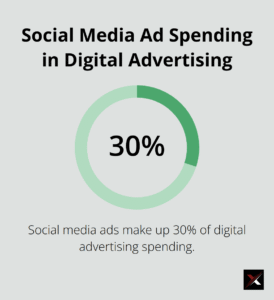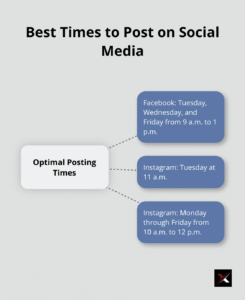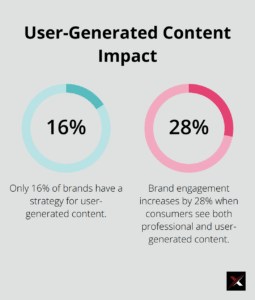At Xzio, we’ve seen firsthand how content and social media marketing work together to create powerful results for businesses.
These two strategies are not just complementary; they’re essential partners in today’s digital landscape.
In this post, we’ll explore how you can harness the synergy between content and social media marketing to boost your brand’s visibility and engagement.
How Content and Social Media Marketing Work Together
The Synergy of Two Powerful Strategies
Content marketing and social media marketing form a dynamic duo in the digital landscape. Content marketing creates valuable, relevant material to attract and retain a specific audience. Social media marketing distributes that content and engages with audiences directly on various platforms.
When these strategies join forces, they create a powerful synergy. Content provides the substance that fuels social media interactions, while social media offers ideal channels for content distribution and audience engagement.
Amplifying Reach and Engagement
The integration of content and social media marketing significantly boosts a brand’s reach and engagement. Social media ads account for 3 in every 10 dollars spent on digital advertising.
Sharing content on social platforms taps into the viral nature of these networks. Users can easily share content with their followers, which exponentially increases the potential audience. This organic spread often results in higher engagement rates and more meaningful interactions with the target audience.

Data-Driven Insights for Strategy Refinement
One of the most significant benefits of combining these strategies is the wealth of data available. Social media platforms provide real-time feedback on content performance, which allows for quick strategy adjustments.
For example, a company might notice that video content on LinkedIn generates more engagement than text posts. This insight can inform the content creation process, helping to produce more of what the audience wants to see.
Optimizing Content for Social Platforms
Different social media platforms have unique characteristics and user behaviors. To maximize the impact of content, it’s essential to optimize it for each platform. This optimization might include:
- Adjusting content length (e.g., shorter posts for Twitter, longer for LinkedIn)
- Using platform-specific features (e.g., Instagram Stories, Facebook Live)
- Tailoring visual elements to fit each platform’s dimensions and style
Leveraging User-Generated Content
Social media provides an excellent opportunity to incorporate user-generated content into a marketing strategy. This approach not only reduces content creation costs but also increases authenticity and builds community around a brand.
Encouraging followers to share their experiences with a product or service (through hashtags or contests) can generate a wealth of content that can be repurposed across various marketing channels.
The integration of content and social media marketing creates a powerful ecosystem for brand growth. As we move forward, we’ll explore how to leverage social media to amplify your content’s reach and impact.
How to Maximize Your Content’s Impact on Social Media
Social media platforms serve as powerful tools for amplifying your content’s reach and impact. Strategic use of these platforms can significantly boost engagement and drive business growth. Here’s how you can leverage social media to get the most out of your content.
Tailor Content to Platform Strengths
Each social media platform boasts unique strengths and audience preferences. LinkedIn favors professional, long-form content, while Instagram thrives on visually appealing, short-form posts. Twitter’s fast-paced environment calls for concise, punchy content that cuts through the noise.
To maximize impact, adapt your content to fit each platform’s strengths. A detailed industry report might transform into an infographic for Instagram, a series of key stat tweets for Twitter, and a full article for LinkedIn.
Optimize Post Timing and Frequency
Timing plays a critical role in social media marketing. Sprout Social reports the best times to post on Facebook are Tuesday, Wednesday, and Friday from 9 a.m. to 1 p.m. For Instagram, it’s Tuesday at 11 a.m. and Monday through Friday from 10 a.m. to 12 p.m. However, these times can vary based on your specific audience, so it’s essential to analyze your own data.
Posting frequency also matters. HubSpot suggests posting 1-2 times per day on Facebook, 3-7 times per week on Instagram, and 1-5 times per day on Twitter. Test different frequencies to find what works best for your audience.

Harness Platform-Specific Features
Each social media platform offers unique features that can boost content engagement. Instagram has 2 billion monthly active users, making it a powerful platform for sharing behind-the-scenes content, teasers for upcoming posts, or quick tips related to your industry.
Facebook Live videos generate 6 times more interactions than regular videos. Consider hosting live Q&A sessions or product demonstrations to increase engagement.
LinkedIn’s article feature allows for long-form content directly on the platform, which can increase your visibility in LinkedIn’s algorithm. Use this for in-depth industry analyses or thought leadership pieces.
Encourage User Interaction
Social media thrives on interaction. Ask questions, run polls, and create content that sparks conversation. Respond promptly to comments and messages to build a strong community around your brand.
Try to create content that users want to share. Infographics, inspiring quotes, and helpful tips often perform well in terms of shares and retweets. The more your audience shares your content, the further your reach extends.
As you implement these strategies, you’ll notice a significant amplification of your content’s reach and impact on social media. The next step is to create content specifically designed for social media success. Let’s explore how to craft content that resonates with your social media audience and drives engagement.
How to Create Viral Content for Social Media
Understand Your Audience Deeply
The first step to create content that drives social media success is to understand your audience’s preferences. Each platform attracts different demographics and behaviors. TikTok users prefer short, entertaining videos, while LinkedIn audiences engage more with professional, informative content.
Platform-specific analytics tools provide insights into your audience’s behavior. Facebook Insights offers detailed information about when your followers are most active. This data helps you schedule posts for maximum visibility and engagement.
Craft Shareable Content
Shareable content extends your reach organically and boosts engagement. But what makes content shareable?
Emotional appeal is a significant factor. A study by the Wharton School of Business found that content which evokes high-arousal emotions like awe, anger, or anxiety is more likely to go viral. However, positive content is shared more often than negative.
Visual content performs exceptionally well on social media. Tweets with images receive 150% more retweets than those without (according to Buffer). Infographics are shared 3x more than other types of content on social media.
Timing also plays a crucial role. Trending topics offer opportunities for viral content. Tools like Google Trends help you identify rising trends in your industry.
Leverage User-Generated Content
User-generated content (UGC) is a powerful tool to drive engagement and build trust. As few as 16% of brands have a strategy regarding user-generated content. According to ComScore, brand engagements rise by 28% when consumers are exposed to both professional content and user-generated product videos.
Encourage your followers to create and share content related to your brand. Run contests or challenges that prompt users to post photos or videos using your products. Repost the best submissions to your official accounts, giving credit to the creators.
GoPro excels at this strategy. Their Instagram feed features stunning user-submitted photos and videos, which showcase the capabilities of their products while engaging their community.

Always obtain permission before using UGC and give proper credit to the creators. This approach not only respects your users but also encourages more people to share content featuring your brand.
Optimize for Each Platform
Different social media platforms have unique characteristics. To maximize impact, adapt your content to fit each platform’s strengths. A detailed industry report might transform into an infographic for Instagram, a series of key stat tweets for Twitter, and a full article for LinkedIn.
Try to use platform-specific features to boost engagement. Instagram Stories (with 2 billion monthly active users) are perfect for sharing behind-the-scenes content, teasers for upcoming posts, or quick tips related to your industry.
Facebook Live videos generate 6 times more interactions than regular videos. Consider hosting live Q&A sessions or product demonstrations to increase engagement.
Encourage Interaction
Social media thrives on interaction. Ask questions, run polls, and create content that sparks conversation. Respond promptly to comments and messages to build a strong community around your brand.
Try to create content that users want to share. Infographics, inspiring quotes, and helpful tips often perform well in terms of shares and retweets. The more your audience shares your content, the further your reach extends.
Final Thoughts
Content and social media marketing form a powerful alliance in today’s digital landscape. These strategies amplify reach, boost engagement, and drive meaningful results when combined effectively. The synergy between content creation and social distribution creates a dynamic ecosystem where valuable content fuels social interactions, and social platforms provide ideal channels for content dissemination.
Social platforms continue to evolve, offering more sophisticated targeting options, enhanced analytics, and new creative tools for content creators. The rise of AI and machine learning will further personalize content delivery, ensuring that the right content reaches the right audience at the right time. This evolution presents exciting opportunities for businesses to refine their integrated content and social media strategies.
Xzio specializes in crafting AI-powered digital marketing strategies that seamlessly integrate content and social media marketing. Our expert team can help you navigate the complexities of these ever-changing landscapes. We strive to ensure your brand stays ahead of the curve and achieves lasting success in the digital realm.

